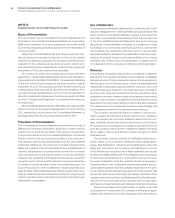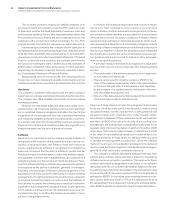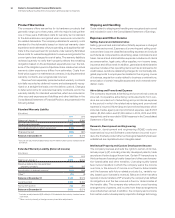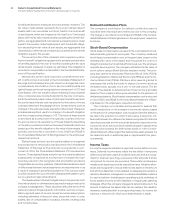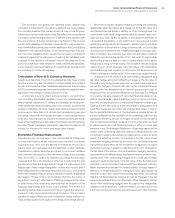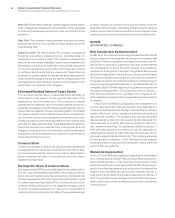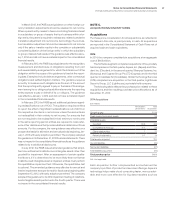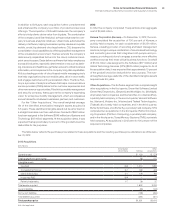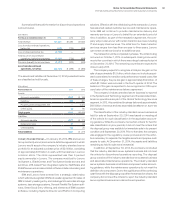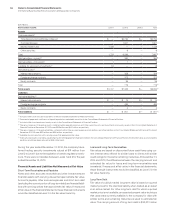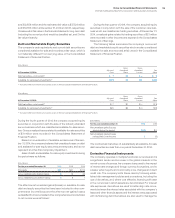IBM 2014 Annual Report Download - page 97
Download and view the complete annual report
Please find page 97 of the 2014 IBM annual report below. You can navigate through the pages in the report by either clicking on the pages listed below, or by using the keyword search tool below to find specific information within the annual report.Notes to Consolidated Financial Statements
International Business Machines Corporation and Subsidiary Companies
96
Write Off—Receivable losses are charged against the allowance
when management believes the uncollectibility of the receivable
is confirmed. Subsequent recoveries, if any, are credited to the
allowance.
Past Due—The company views receivables as past due when
payment has not been received after 90 days, measured from the
original billing date.
Impaired Loans—As stated above, the company evaluates all
financing receivables considered at-risk, including loans, for
impairment on a quarterly basis. The company considers any
loan with an individually evaluated reserve as an impaired loan.
Depending on the level of impairment, loans will also be placed
on non-accrual status as appropriate. Client loans are primarily
for software and services and are unsecured. These loans are
subjected to credit analysis to evaluate the associated risk and,
when deemed necessary, actions are taken to mitigate risks in the
loan agreements which include covenants to protect against credit
deterioration during the life of the obligation.
Estimated Residual Values of Lease Assets
The recorded residual values of lease assets are estimated at
the inception of the lease to be the expected fair value of the
assets at the end of the lease term. The company periodically
reassesses the realizable value of its lease residual values. Any
anticipated increases in specific future residual values are not rec-
ognized before realization through remarketing efforts. Anticipated
decreases in specific future residual values that are considered to
be other-than-temporary are recognized immediately upon iden-
tification and are recorded as an adjustment to the residual value
estimate. For sales-type and direct-financing leases, this reduction
lowers the recorded net investment and is recognized as a loss
charged to financing income in the period in which the estimate is
changed, as well as an adjustment to unearned income to reduce
future-period financing income.
Common Stock
Common stock refers to the $.20 par value per share capital stock
as designated in the company’s Certificate of Incorporation. Trea-
sury stock is accounted for using the cost method. When treasury
stock is reissued, the value is computed and recorded using a
weighted-average basis.
Earnings Per Share of Common Stock
Earnings per share (EPS) is computed using the two-class method.
The two-class method determines EPS for each class of common
stock and participating securities according to dividends and
dividend equivalents and their respective participation rights
in undistributed earnings. Basic EPS of common stock is com-
puted by dividing net income by the weighted-average number
of common shares outstanding for the period. Diluted EPS of
common stock is computed on the basis of the weighted-average
number of shares of common stock plus the effect of dilutive
potential common shares outstanding during the period using the
treasury stock method. Dilutive potential common shares include
outstanding stock options, stock awards and convertible notes.
NOTE B.
ACCOUNTING CHANGES
New Standards to be Implemented
In May 2014, the Financial Accounting Standards Board (FASB)
issued guidance on the recognition of revenue from contracts with
customers. Revenue recognition will depict the transfer of prom-
ised goods or services to customers in an amount that reflects
the consideration to which the entity expects to be entitled in
exchange for those goods or services. The guidance also requires
disclosures regarding the nature, amount, timing and uncertainty
of revenue and cash flows arising from contracts with customers.
The guidance permits two methods of adoption: retrospectively to
each prior reporting period presented, or retrospectively with the
cumulative effect of initially applying the guidance recognized at
the date of initial application. The guidance is effective January1,
2017 and early adoption is not permitted. The company is cur-
rently evaluating the impact of the new guidance and the method
of adoption.
In April 2014, the FASB issued guidance that changed the cri-
teria for reporting a discontinued operation. Only disposals of a
component that represents a strategic shift that has (or will have)
a major effect on an entity’s operations and financial results is a
discontinued operation. The guidance also requires expanded
disclosures about discontinued operations and disposals of a
significant part of an entity that does not qualify for discontin-
ued operations reporting. The guidance is effective January1,
2015 with early adoption permitted, but only for disposals (or
classifications as held for sale) that have not been reported in
previously-issued financial statements. The company will adopt
the new guidance on January1, 2015. The impact to the company
will be dependent on any potential transaction that is within the
scope of the new guidance.
Standards Implemented
In July 2013, the FASB issued guidance regarding the presentation
of an unrecognized tax benefit when a net operating loss carryfor-
ward, a similar tax loss, or a tax credit carryforward exists. Under
certain circumstances, unrecognized tax benefits should be pre-
sented in the financial statements as a reduction to a deferred tax
asset for a net operating loss carryforward, a similar tax loss, or
a tax credit carryforward. The guidance was effective January1,
2014. The guidance was a change in financial statement presen-
tation only and did not have a material impact in the consolidated
financial results.


